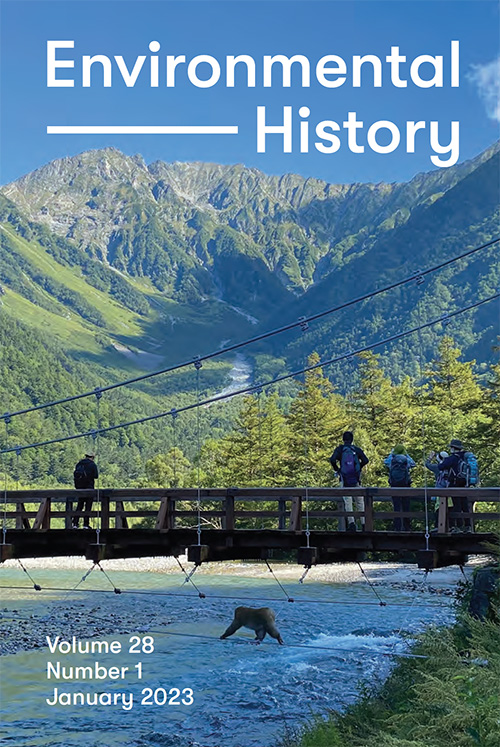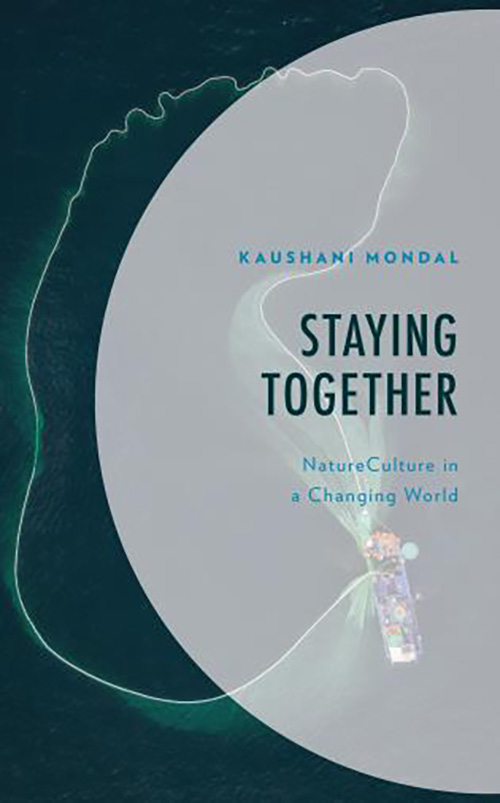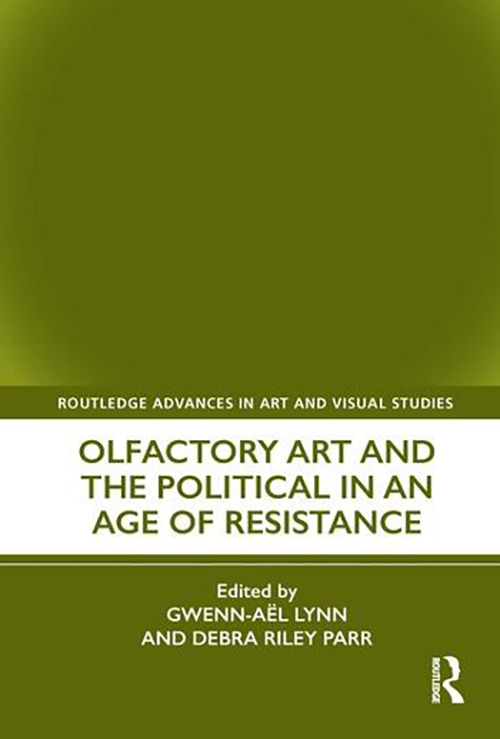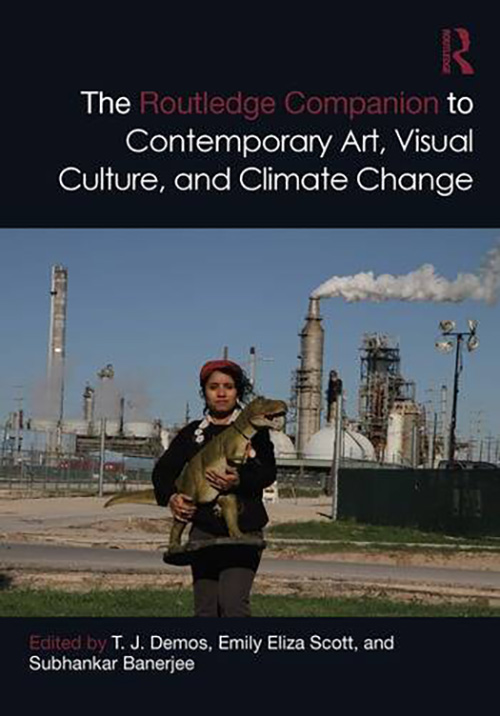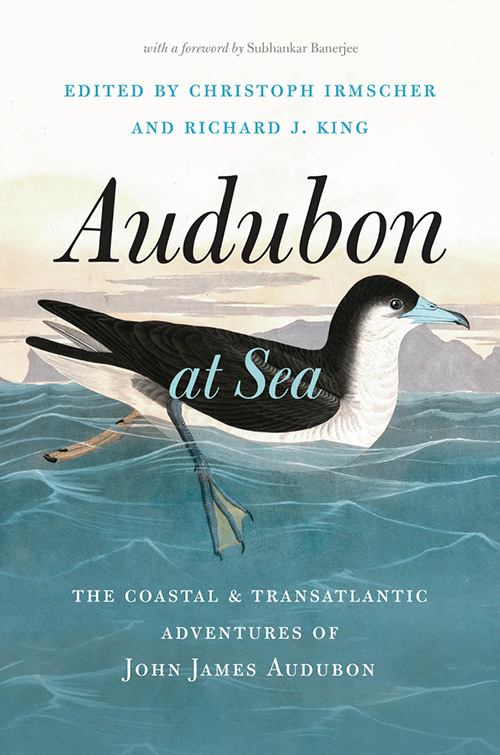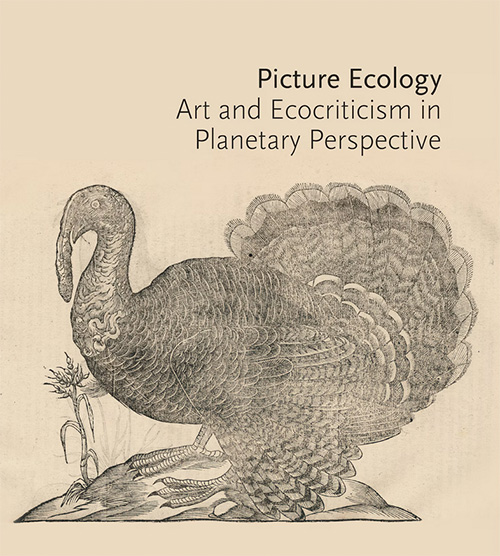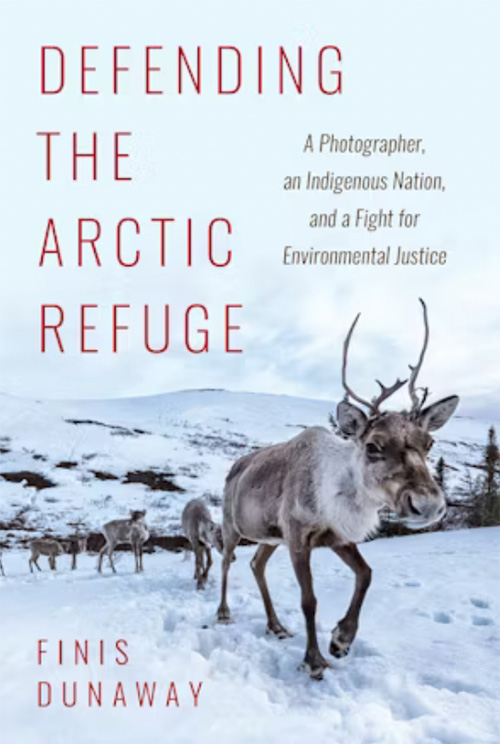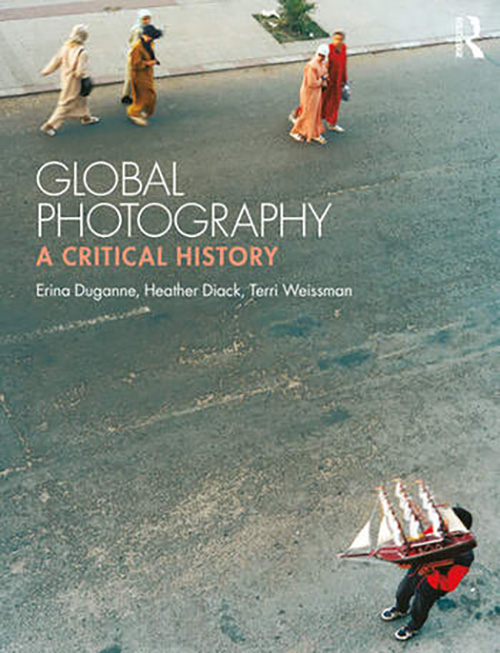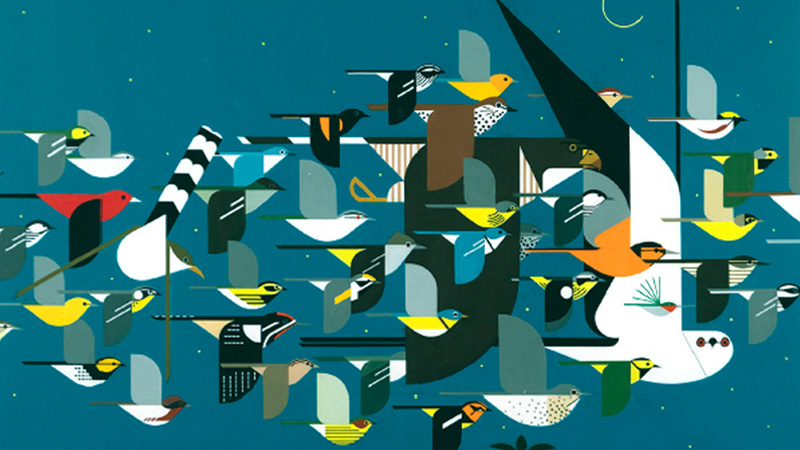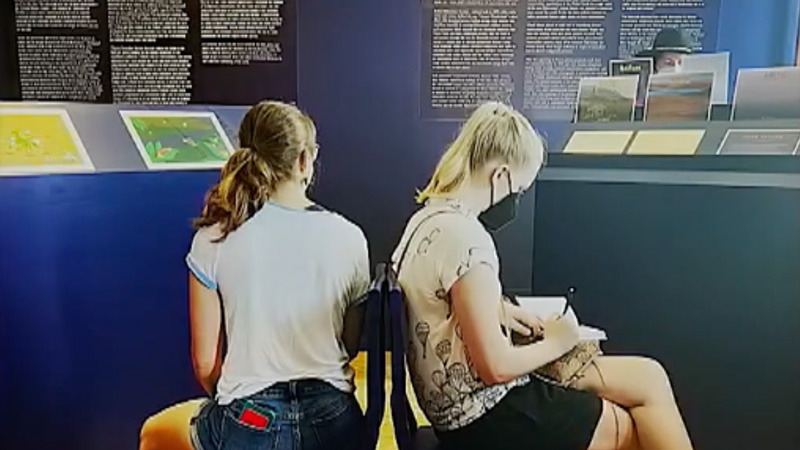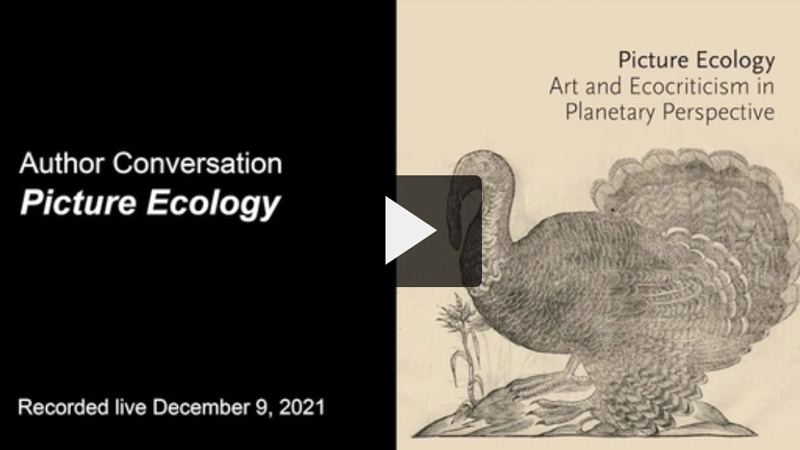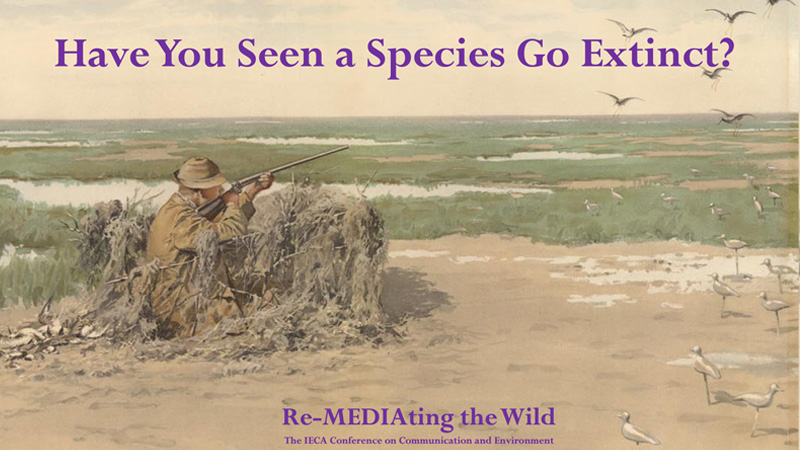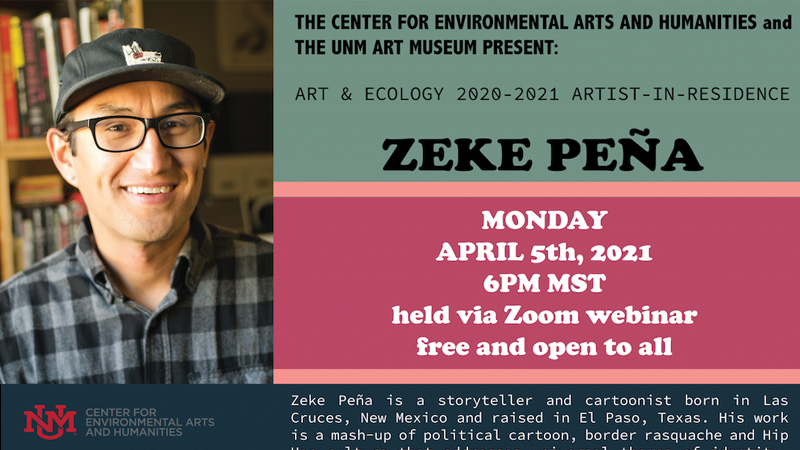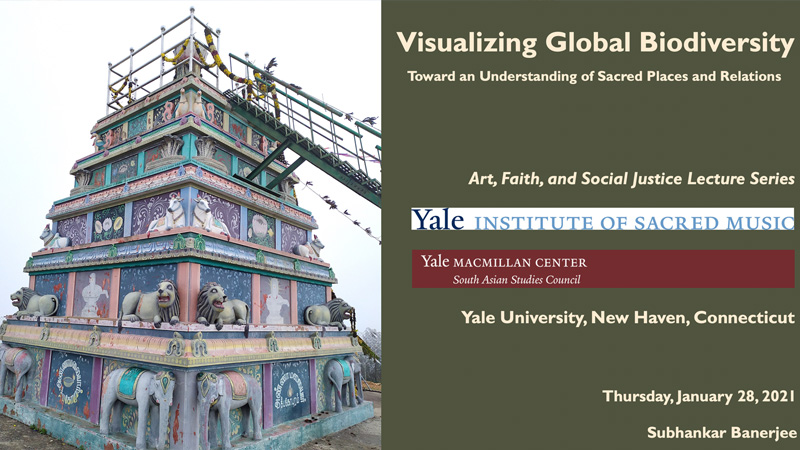Center for Environmental Arts & Humanities
Nanibah “Nani” Chacon (Diné and Chicana), painter, muralist and UNM alumna, speaking to UNM students in front of her mural, Constellations, Valle de Oro National Wildlife Refuge, Albuquerque, New Mexico (photo Subhankar Banerjee, March 20, 2024).
The Center for Environmental Arts & Humanities (CEAH) is an interdisciplinary biodiversity and climate change initiative at UNM.
The CEAH fosters research-based creative practices and scholarship in environmental humanities to address—what many people consider—are the two most consequential planetary-scale crises in human history: ‘biological annihilation’, which includes species extinctions and population declines; and ‘climate breakdown’, variously called, climate change, climate emergency, and global warming.

About the Center for Environmental Arts & Humanities
At the historic 1992 ‘Earth Summit’ in Rio de Janeiro, the United Nations acknowledged the severity and significance of both climate and the biodiversity crises and established two separate institutions: the UN Framework Convention on Climate Change (UNFCCC), to address the climate crisis; and the Convention on Biological Diversity (CBD), to address the biodiversity crisis. The efforts of the UNFCCC led to the Paris (Climate) Agreement in 2015; and the efforts of the CBD led to the Kunming-Montreal Global Biodiversity Framework in 2022.
Painter and UNM alumna Jaune Quick-to-See Smith’s (Confederated Salish and Kootenai Nation), All of My Relations I + II, 2022, two five-color lithograph accordion books with chine collé, was created in collaboration with Valpuri Remling, Master Printer, UNM Tamarind Institute. It was first introduced in “a Library, a Classroom, and the World,” which was co-produced by CEAH and the Environmental Studies Department at Davidson College, and was included in the 2022 Venice Biennale art exhibition Personal Structures, organized by the European Cultural Centre in Venice, Italy, April 23 – November 27, 2022. Courtesy Tamarind Institute.
While attentive to scientific knowledge and the UN science-policy initiatives, the research and creative practices at CEAH are foregrounded in arts, culture, and humanities. Some of the key concepts and themes that the CEAH-supported artists and scholars focus on are—multispecies coexistence, kinship, caretaking, and justice; rights-based biodiversity conservation; and climate and environmental justice. Our work is place-based and community-engaged, and span from local (Albuquerque and New Mexico) and regional (the US southwest), to transnational (US-Mexico and US-Canada borderlands) and global (Alaska to Aotearoa; Sundarban to Siberia).
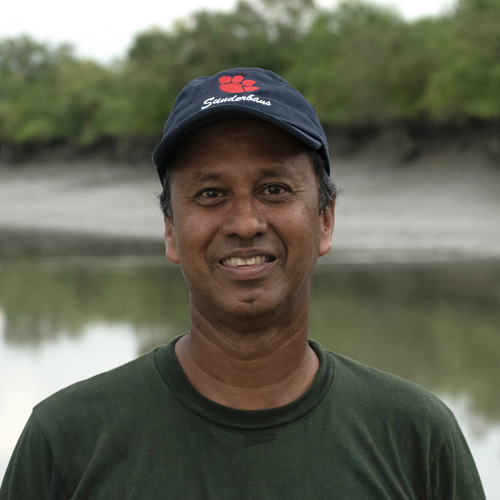
Director's Welcome
Greetings from the New Mexico desert! Thank you for visiting the webpage of the Center for Environmental Arts & Humanities. The Center for Environmental Arts & Humanities is able to bring together research-based creative practices and scholarship in environmental humanities within a single initiative in part because of how the Department of Art is structured, which includes three distinct areas under the same roof: art education; art history; and studio arts. From that disciplinary home, the CEAH serves the whole academic community of UNM. Our students, undergraduate and graduate, and faculty collaborators come from a number of colleges, departments, centers, and institutes from across the UNM, including the College of Fine Arts, School of Architecture and Planning, College of Arts & Sciences, Indigenous Design + Planning Institute, and the Center for Regional Studies, to name just a few.
The Library in Palazzo Bembo, “a Library, a Classroom, and the World,” which was co-produced by CEAH and the Environmental Studies Department at Davidson College, and was included in the 2022 Venice Biennale art exhibition Personal Structures, organized by the European Cultural Centre in Venice, Italy, April 23 – November 27, 2022.
Beyond UNM, the CEAH works with academic, cultural, government and non-governmental institutions in New Mexico and across North America, and many parts of the world. We aim to build bridges across academic disciplinary silos; between academia and communities; across peoples and places; and across time. With exhibitions, publications, and events—the CEAH produces and disseminates knowledge and advances public literacy about our precarious time—a time in which we are a witness to human-caused ‘biological annihilation’ and ‘climate breakdown’. We offer support to students, scholars and professional artists through a combination of programs: the Native American Environmental Arts and Humanities Scholarship for undergraduate students; graduate and undergraduate fellowships and scholarships; the Artist-in-Residence program for established artists; and support to visiting artists and scholars, and to our collaborating institutions.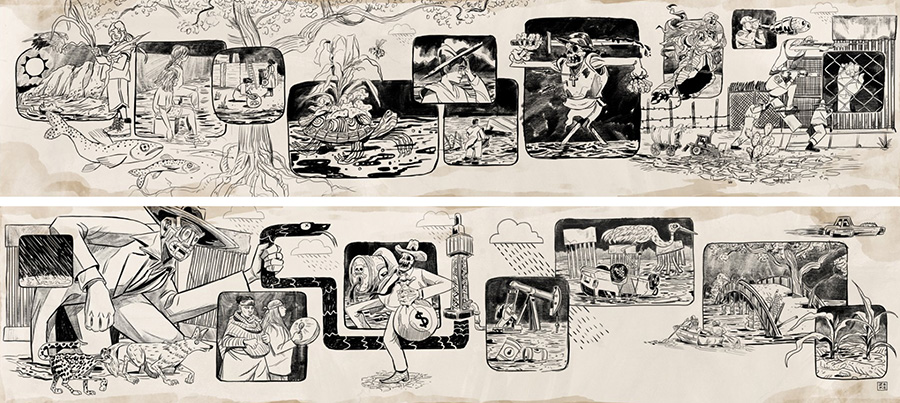
Chicano cartoonist and storyteller Zeke Peña’s two-part illustration, The River (Remix), was first introduced in a greyscale version in “a Library, a Classroom, and the World,” Palazzo Bembo, Venice, Italy, April 23 – November 27, 2022. Zeke Peña was the inaugural CEAH Artist-in-Residence (2020-2021), and worked on The River (Remix) during the residency.
I encourage you to read the various illustrated CEAH pages and explore the weblinks that you will find to learn more about our work. —Subhankar Banerjee, founding director, CEAH at UNMOrigin Story
In a May 2017 grant proposal to the Mellon Foundation, we articulated a vision and the need to establish an interdisciplinary arts and humanities center at UNM. Over a three-year period, from 2017 through 2019, faculty members and students from across UNM, in partnership with academic and cultural institutions, organized a number of regional, national, and transnational creative and scholarly events that collectively addressed biodiversity and the climate crises, Indigenous rights, and environmental and climate justice. Two conferences, Decolonizing Nature (2017), and the last oil (2018); and an exhibition, Species in Peril Along the Rio Grande (2019), helped build a community of cohorts and a foundation on which the Center for Environmental Arts & Humanities was established in April 2020.
On April 6, 2020, in the midst of the coronavirus pandemic, just as cities, states and nations were starting to institute lockdowns to contain the spread of Covid-19—the Center for Environmental Arts & Humanities was established with support from a five-year (2017-2022) seed grant from the Mellon Foundation, as a Category I interdisciplinary research center in the Department of Art of the College of Fine Arts at the University of New Mexico.
Few months after its founding, in Fall 2020, the CEAH organized the Biodiversity Webinar Series, in which then-US Senator Tom Udall served as the honorary co-host.

Undergraduate students and faculty of the Environmental Studies Department of Davidson College in the outdoor Classroom in Giardini della Marinaressa along the Venice Lagoon, “a Library, a Classroom, and the World,” which was co-produced by CEAH and Davidson College and included in the 2022 Venice Biennale art exhibition Personal Structures, organized by the European Cultural Centre in Venice, Italy, April 23 – November 27, 2022 (photo Subhankar Banerjee, May 20, 2022).
The following year, Center for Environmental Arts & Humanities was invited to participate in a Venice Biennale exhibition. The CEAH, in partnership with the Environmental Studies Department at Davidson College, co-produced “a Library, a Classroom, and the World,” which was included in the 2022 Venice Biennale art exhibition Personal Structures organized by the European Cultural Centre (ECC) in Venice, Italy. Personal Structures included 192 projects (or participants) from 51 countries and was seen by over 500,000 visitors from around the world during its seven-month display from April through November 2022. At the closing ceremony, “a Library, a Classroom, and the World” received the ECC Award for University and Research Project.
In August 2022, the CEAH received a renewal grant (2022-2026) from the Mellon Foundation to “support the continuation of the Center’s exploration of environmental issues through creative inquiry, practice, and pedagogy.”

UNM undergraduate students at the exhibition Postcards Are for Active Participation, Not for Passive Viewing, UNM Fine Arts & Design Library, May 3 – July 7, 2023 (photo Stephanie Beene, May 3, 2023).
The following year, back at UNM, the CEAH produced a small exhibition, Postcards Are for Active Participation, Not for Passive Viewing, with works by twenty undergraduate students who at the time were studying in five different colleges at UNM. The exhibition was hosted at the UNM Fine Arts & Design Library, May 3 – July 7, 2023.
What We Are Working On

Postcards created by UNM undergraduate students Leila Chapa (left) and Paloma Chapa (right) will be included in the book and the companion exhibition, Coexistence: Biodiversity in New Mexico, 2024.
The Center for Environmental Arts & Humanities (CEAH) is currently providing support for and working on the book, Coexistence: Biodiversity in New Mexico (UNM Press, 2026). With about 25 chapters written for this volume by artists, scientists, journalists, scholars, and conservationists from across the state, Coexistence: Biodiversity in New Mexico will be an expansive and richly illustrated first-of-its-kind book that will honor New Mexico’s biodiversity and human-nonhuman coexistence and kinship across a vast span of time, from the late-Pleistocene to the present day. It will celebrate the creative and cultural practices of the Indigenous peoples of New Mexico as it relates to nonhuman animals and plants. It will highlight the history and politics of conservation, and the history of science in the US-Mexico borderlands. It will highlight contemporary practices in art and visual culture and journalism; scholarship in environmental and geo humanities, and natural and social sciences. It will draw attention to various cultural and science-based efforts of biodiversity conservation. With transdisciplinary perspectives and varieties of creative and cultural practices, Coexistence: Biodiversity in New Mexico will address the intensifying biodiversity crisis. It will also offer a more inclusive and just model of biodiversity conservation, one founded on the idea of coexistence, and not exclusion and eviction of Indigenous and other rural peoples from conservation worthy areas. Coexistence: Biodiversity in New Mexico will be edited by CEAH Director, Subhankar Banerjee. The book will be accompanied by a statewide exhibition.
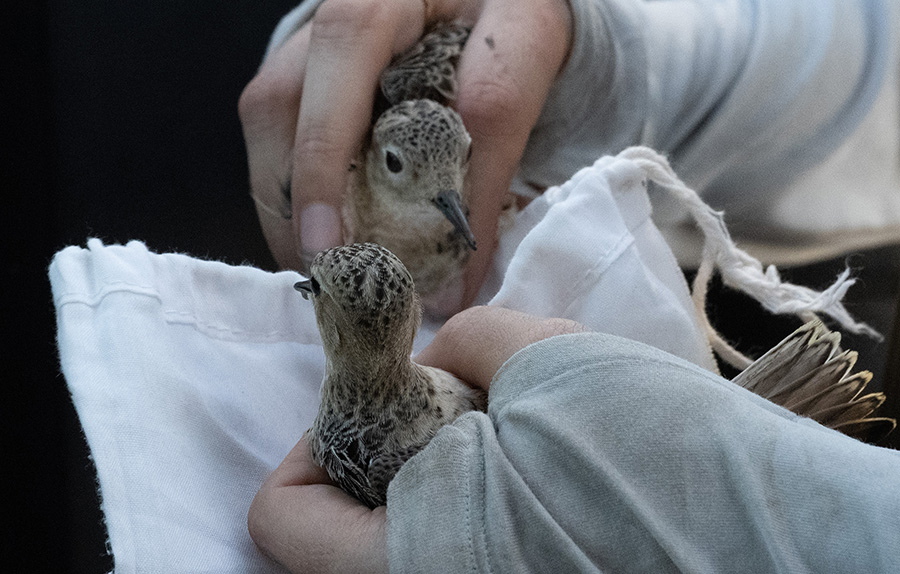
Ornithologist Tara Rodkey working on Buff-breasted Sandpiper during the fall stopover in Texas, an imperiled shorebird species that nests in the Arctic tundra of North America and spends the non-breeding season in the Pampas grasslands of South America (photo Subhankar Banerjee, August 2023).
The Center for Environmental Arts & Humanities is also providing support for archival and field research on the global history and migrations of shorebirds, which will result in a multi-volume book, Shorebirds in Modern Times, and a companion art and visual culture exhibition at the Anchorage Museum in Alaska.
Recent and Forthcoming Publications
Along with exhibitions and events, the Center for Environmental Arts & Humanities contributes to the advancement of environmental knowledge and public literacy through publications—books, book chapters, journal essays, and public writing. In addition to the exhibitions-attached books mentioned in the 'Exhibitions' section, we list below a small selection of recent publications by faculty and students at UNM (supported by CEAH) and collaborators at other institutions; and a few important publications by colleagues in which our work is discussed.
Subhankar Banerjee, “Peripatetic Photography: Crossing Borders, Building Bridges,” in Global Photography: A Critical History, by Terri Weissman, Erina Duganne and Heather Diack (Routledge, 2020).
Senator Tom Udall and Subhankar Banerjee, “We Must Mobilize to Avert a Lonely Earth,” Scientific American, October 20, 2020.
T.J. Demos, Emily Eliza Scott, and Subhankar Banerjee, eds. Routledge Companion to Contemporary Art, Visual Culture and Climate Change (Routledge, 2021; paperback 2023).
Eleonora Edreva, “Olfactory Resistance at the End of the World,” in Olfactory Art and the Political in an Age of Resistance, edited by Gwenn-Aël Lynn and Debra Riley Parr (Routledge, 2021).
Alexandria Zuniga de Dóchas, “Ensuring biodiversity is up to us,” Santa Fe New Mexican, December 11, 2021.
Finis Dunaway, Defending the Arctic Refuge: A Photographer, an Indigenous Nation, and a Fight for Environmental Justice (University of North Carolina Press, 2021).
Karl Kusserow, ed. Picture Ecology: Art and Ecocriticism in Planetary Perspective (Princeton University Art Museum, 2021).
Jackson Larson, Make Haste Slowly: Pietro Bembo’s Influence on the Printed Word, A Short Reflection, included in “a Library, a Classroom, and the World” project of the 2022 Venice Biennale art exhibition Personal Structures (UNM CEAH and the European Cultural Centre, 2022).
Subhankar Banerjee, “Foreword,” in Audubon at Sea: The Coastal and Transatlantic Adventures of John James Audubon, edited by Christoph Irmscher and Richard J. King (The University of Chicago Press, 2022).
Lisa E. Bloom, Climate Change and the New Polar Aesthetics: Artists Reimagine the Arctic and Antarctic (Duke University Press, 2022).
Subhankar Banerjee and Finis Dunaway, “Beyond Fortress Conservation: Postcards of Biodiversity and Justice,” Environmental History, vol. 28 no. 1, January 2023, 180-207.
Jennifer Garcia Peacock, “Zeke Pena: Illustrating Chicanx Environmental Justice Histories in the Rio Grande Watershed,” in The Routledge Companion to Art and Activism in the Twenty-First Century, edited by Lesley Shipley and Mey-Yen Moriuchi (Routledge, 2023).
Juliana Ramírez Herrera, “The bio-art history of care: mummy-sculptures of the Atacama desert,” Sculpture Journal, volume 32, issue 2, June 2023, 157-174.
Leah Modigliani, Counter Revanchist Art in the Global City: Walls, Blockades, and Barricades as Repertoires of Creative Action (Routledge, 2023).
Subhankar Banerjee, “Visualizing Staying Together: Multispecies Kinship, Caretaking, Justice, and Rebellion,” in Staying Together: Nature-culture in a Changing World, edited by Kaushani Mondal (Lexington Books, Rowman and Littlefield, ‘Environment and Society’ series, 2024).
Jennifer Garcia Peacock, “Our Classroom: Reflections on Teaching Global Environmental Justice Art in the Venice Lagoon,” in Staying Together: Nature-culture in a Changing World, edited by Kaushani Mondal (Lexington Books, Rowman and Littlefield, ‘Environment and Society’ series, 2024).
Subhankar Banerjee and Finis Dunaway, “Tracks, Traces, and Signs: Multispecies Justice in the River Deltas of Arctic Alaska and Sundarban,” in River Delta Futures: Endangered Communities in Audiovisual Media, edited by Francisco-J. Hernández Adrián and Angelos Theocharis (Bloomsbury Academic, ‘Global Challenges in Environmental Humanities’ series, forthcoming 2024).
Subhankar Banerjee and Finis Dunaway, “Beyond Fortress Conservation: A Global History of Biodiversity and Justice” (provisional book title).
CEAH Faculty & Staff
 Subhankar Banerjee
Subhankar Banerjee
Professor, Art & Ecology
Founding Director, CEAH
 Clarence Cruz
Clarence Cruz
Associate Professor, Ceramics
CEAH Native American Scholarship Committee
 Meg Elcock
Meg Elcock
Academics Coordinator, Department of Art
Scholarship Support
 Dr. Marcella Ernest (Ojibwe)
Dr. Marcella Ernest (Ojibwe)
Assistant Professor, Art History
CEAH Native American Scholarship Committee
 Aaron Fry
Aaron FryLecturer II Art History
CEAH Native American Scholarship Committee
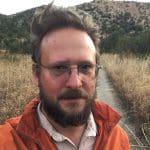 Ryan Henel
Ryan Henel
Research Lecturer III
CEAH
 Jacklyn Le
Jacklyn Le
Marketing Rep, Department of Art
Webpage Support
 Ellen Peabody
Ellen Peabody
Administrative Support
 Danette Petersen
Danette Petersen
Accountant II, Department of Art
Accounting Support
Support
The Center for Environmental Arts & Humanities gratefully acknowledges the generous financial support of the Mellon Foundation; and financial, administrative, and infrastructural support of the Department of Art at UNM.
The Center for Environmental Arts & Humanities offer support to students, scholars and professional artists through a combination of programs: the Native American Environmental Arts and Humanities Scholarship for undergraduate students; graduate and undergraduate fellowships and scholarships; the Artist-in-Residence program for established artists; and support to visiting artists and scholars, and to our collaborating institutions.

Drawing and writing by Janessa Bowekaty (Zuni Pueblo), Shiwi Girl, 2020. In 2022-2023, during her senior undergraduate year at UNM, Janessa Bowekaty received a Native American Environmental Arts and Humanities Scholarship from the CEAH. She graduated with a bachelor’s degree in Spring 2023, and returned to UNM as a graduate student in Native American Studies in Fall 2023. She holds a graduate scholarship from the CEAH for 2023-2024, and is creating new works that will be included in the exhibition, Coexistence: Biodiversity in New Mexico.

Trans Latinx artist Alexandria Zuniga de Dóchas created two digital illustrations, Birds of the Earth (left) and Mammals of the Earth (right), in 2022, with a graduate fellowship from the CEAH while an MFA student in Art & Ecology at UNM. Prints of these two illustrations were first introduced in “a Library, a Classroom, and the World,” which was co-produced by CEAH and the Environmental Studies Department at Davidson College, and was included in the 2022 Venice Biennale art exhibition Personal Structures, organized by the European Cultural Centre in Venice, Italy, April 23 – November 27, 2022.
We are honored to celebrate the work of the artists of the CEAH Artist-in-Residence program, all of whom either hail from or currently reside in New Mexico: Chicano cartoonist and storyteller Zeke Peña (2020-2021); Diné and Chicana painter and muralist Nanibah “Nani” Chacon (2023-2024); Piro Manso Tiwa painter, muralist, poet, and tribal historian Diego Medina (2024); science illustrator Karen Carr (2024); and African American mixed media artist Paula Wilson (2024-2025). Their work, along with the works by students and alumni supported by the CEAH, will form the core of the exhibition, Coexistence: Biodiversity in New Mexico.
News
CEAH Director Subhankar Banerjee has been named the 45th Ashley Fellow at Trent University in Canada.
Arly Garcia, “Daily Lobo twins for the win,” Daily Lobo, May 6, 2024.
“Postcard exhibition invites audience contributions,” UNM News, May 1, 2023.
Mary Beth King. “UNM group receives award for Venice Biennale project,” UNM News, December 20, 2022.
“a Library, a Classroom, and the World” received the 2022 ECC Award for University and Research Project. “a Library, a Classroom, and the World” was co-produced by CEAH and the Environmental Studies Department at Davidson College, and was included in the 2022 Venice Biennale art exhibition Personal Structures, organized by the European Cultural Centre in Venice, Italy, April 23 – November 27, 2022.
Michael Abatemarco. “Queen of the Adriatic receives UNM,” Santa Fe New Mexican, September 30, 2022.
Ivan Leonard. “Going International: UNM represented at prestigious art expo in Venice,” Albuquerque Journal, June 29, 2022.
Mary Beth King. “UNM group participates in prestigious Venice art exhibition,” UNM News
Select Webinars
The Wonder of Birds: Online Art Lecture Series
Museum of American Bird Art, Mass Audubon, Spring 2024
Webinar Series: Mass Extinction: Art, Ritual, Story, and the Sacred
Yale Institute of Sacred Music, Yale University, Spring 2023
On “a Library, a Classroom, and the World”
(CEAH contribution to Venice Biennale exhibition Personal Structures)
San Francisco Public Library, July 31, 2022
Author Conversation: Picture Ecology
Princeton University Art Museum, December 9, 2021
Keynote lecture, “Have you seen a species go extinct?”, Re-MEDIAting the Wild international conference
International Environmental Communication Association, June 21, 2021
Zeke Peña: CEAH inaugural Artist-in-Residence lecture
Co-hosted by CEAH and the UNM Art Museum, April 5, 2021
Book Launch: Routledge Companion to Contemporary Art, Visual Culture, and Climate Change
Co-hosted by University of Oregon’s Center for Environmental Futures, UCSC’s Center for Creative Ecologies, and UNM’s CEAH, April 2, 2021
Visualizing Global Biodiversity: Toward an Understanding of Sacred Places and Relations
(Art, Faith, and Social Justice Lecture Series)
Co-hosted by Institute of Sacred Music and McMillan Center South Asian Studies Council, Yale University, January 28, 2021
UNM Biodiversity Webinar Series
Presented by the Species in Peril project (later subsumed into CEAH) with US Senator Tom Udall as honorary co-host, Fall 2020

